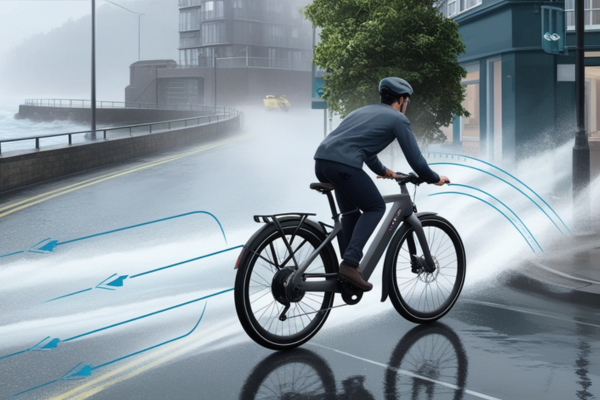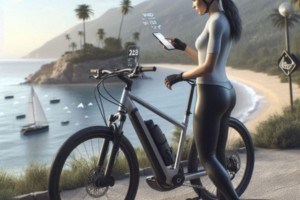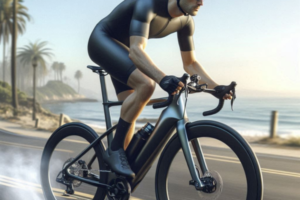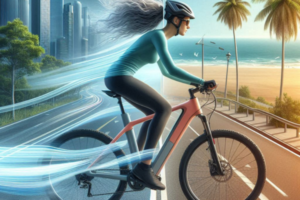Humidity wind resistance electric bicycles—three elements that define the riding experience in coastal environments. Whether you commute through sea mist at sunrise or pedal through humid afternoons near the ocean, your electric bike is constantly interacting with an invisible force: air saturated with moisture. 🌫️⚡
This air doesn’t just feel different—it behaves differently. Riders often notice their e-bike feeling heavier, slower, or less responsive after just a few minutes. What’s really happening is that humidity increases wind resistance, making it harder for air to move cleanly around your bike and body. That extra drag means your motor must work harder and your battery drains faster, even when the terrain hasn’t changed. 🌬️🔋
🚲 How Humidity Affects Wind Resistance in Electric Bicycles
Humid air is packed with microscopic water particles that behave like invisible debris. These droplets don’t just float—they cling. They attach to your clothing, your frame, your panniers, and even your helmet. This changes how air flows around you. Instead of a smooth, laminar flow, you get turbulent airflow, which increases drag. This happens more aggressively in electric bicycles, which already have more frontal surface due to their motor, battery enclosure, and accessories.
In dry conditions, wind slips over your bike’s surfaces. In humid air, it’s like pushing through a light mist that grabs at every exposed part. You may not see it, but you definitely feel it. And it’s not just discomfort—it’s measurable aerodynamic resistance that costs you energy. 🧪
Electric bicycles are particularly vulnerable to this because of their geometry and structure. Most e-bikes include bulkier tubing, visible wiring, and larger profile areas than standard bicycles. All of these features disrupt airflow even more when they’re wet or coated in fine salt from coastal environments. That roughness increases wind resistance and reduces your battery’s efficiency. 🔄
💬 Real-World Example: Natalia, an e-bike commuter from Santa Marta, noticed her battery dropped from 70% to 48% on identical routes—only difference was high morning humidity. After cleaning her frame and sealing her panniers, she regained almost 10% range in a week.
🔎 Signs That Humidity Is Affecting Your Ride
- ⚠️ The motor heats up more quickly than usual
- ⚠️ You feel unexpected drag even on flat terrain
- ⚠️ Your battery drains faster on foggy or misty days
- ⚠️ There’s more wind noise around accessories or panniers
- ⚠️ You notice condensation on your gear or clothing
These are not just annoyances—they’re aerodynamic warnings. Over time, they reduce your e-bike’s lifespan and performance. And the more often you ride in humid, coastal conditions, the more urgent it becomes to understand how humidity wind resistance electric bicycles interact. 💡
The great news is that these issues are manageable. With awareness and targeted adjustments, you can regain speed, range, and comfort. The following strategies don’t require expensive upgrades—they begin with how you ride, how you maintain your bike, and how you prepare for the air around you. 🌊🔧
Humidity wind resistance electric bicycles create a subtle but powerful aerodynamic interaction that often goes unnoticed until your battery drains too quickly or your ride feels unusually sluggish. Understanding why humid air increases wind resistance begins with how it behaves—especially when in motion and in contact with your bike’s surfaces. 🌫️🔍
While it’s true that humid air is technically less dense than dry air, it carries significantly more water vapor. These microscopic droplets cling to everything: handlebars, clothing, panniers, tires, and even exposed cables. When your e-bike moves through this saturated air, the moisture disturbs the normal airflow, creating drag and reducing efficiency. In short: you’re pushing not just through wind, but through wet, sticky resistance. 🌀
🌬️ The Science Behind Humidity, Wind Resistance, and E-Bikes
When air moves over a cyclist and their bike, it ideally forms a streamlined flow. In dry weather, this laminar flow stays close to the surface and allows air to glide smoothly over and around you. But in high humidity, water vapor disrupts this clean flow. Moisture particles cling to your frame and clothes, creating a rougher surface. That disruption causes the air to separate earlier, increasing turbulence and the size of the wake behind you.
This aerodynamic wake—the low-pressure zone that trails behind any moving object—becomes larger and more chaotic when moisture is present. Your motor then has to work harder to maintain speed, burning through more energy for the same distance. The result? Shorter battery range, more effort, and a hotter motor, especially in coastal conditions where these factors converge. 🔋💨
Electric bicycles are even more affected due to their shape and components. Unlike road bikes with minimal gear, e-bikes come equipped with batteries, controllers, display screens, and often panniers or cargo racks. All these features create more frontal area and disrupt airflow further—especially when moist air sticks to their surfaces. 🌁
📊 Field Insight: Diego, a coastal rider in Cartagena, tracks his battery every day. On dry days, he averages 28 km. On mornings above 85% humidity, the same effort only gives him 21–23 km. Cleaning his battery case weekly and switching to slim panniers helped him regain 3 km per ride.
🔧 Why It Matters More for Electric Bicycles
Most e-bike riders focus on battery life, tire pressure, or motor specs—but few consider how the air itself can become a form of resistance. In humid climates, your bicycle’s aerodynamic profile becomes a central factor in energy use. The heavier and more humid the air, the more energy it takes to move through it—especially when your bike isn’t shaped or treated to handle it.
Humidity also causes surfaces to stay wet longer. This means you’re not just moving through thick air—you’re also riding with damp accessories, sticky cables, and soaked clothing, all of which contribute to drag. Over time, this invisible resistance builds up and quietly erodes your performance and comfort. ⚙️
Being aware of how humidity wind resistance electric bicycles interact is the first step to doing something about it. In the next phase, it’s time to move from understanding the problem to actively solving it—with small, smart adjustments that help your ride cut through the air with less effort and more confidence. 🚴♀️
Humidity wind resistance electric bicycles don’t need to be a constant source of frustration. While humid air will always be part of coastal riding, smart, practical adjustments can reduce its aerodynamic impact significantly. Many of these changes cost little or nothing—they just require awareness, habit, and consistency. 🧠🔧
Your riding posture is one of the most powerful tools to combat drag. Most riders adopt a more upright stance for comfort, but this increases the amount of body exposed to moisture-laden wind. Adjusting your form can reduce resistance dramatically. Lean slightly forward, lower your elbows, and align your spine naturally. This allows air to flow around your body more cleanly—particularly when it’s saturated with water vapor. 🧘♀️
🚴♂️ Practical Adjustments to Fight Humidity Wind Resistance in Electric Bicycles
Clothing also matters. Loose, flapping garments not only absorb moisture—they disrupt airflow. Switching to fitted, synthetic cycling gear helps reduce turbulence. Jerseys with smooth fabric, compression sleeves, and snug gloves can transform how wind moves across your body. In humid air, even small wrinkles or soaked fabric panels increase drag more than you’d expect. 👕🌬️
When it comes to accessories, aerodynamics should guide your choices. Avoid front baskets, boxy panniers, and wide fenders. Instead, use tapered panniers, rounded handlebar bags, and rear racks with smooth tubing. These shapes create less disruption as wind moves past—and they’re easier to keep dry and clean. 🧳💼
Surface care is another key area. Dirty or damp bike frames create more friction against the air. Applying water-repellent spray or ceramic coating can keep your surfaces smooth and reduce resistance. These treatments also help repel road grime, making your bike easier to clean and helping it retain its aerodynamic integrity even after a rainy week. 💦🚿
🛠️ Pro Tip: Apply silicone spray to your battery case and fork once a week. It helps water slide off, reduces drag, and prevents corrosion—especially in salty air environments like Barranquilla or Key West.
🧼 The Role of Cleanliness in Aerodynamic Efficiency
Humidity makes dirt stick. After a ride near the ocean, microscopic salt and moisture particles cling to your bike’s surfaces, cables, and moving parts. This roughens the surface and slows airflow. A clean bike not only looks better—it performs better. Rinse with fresh water, dry with a microfiber cloth, and clean your drivetrain weekly with a waterproof lube. 🧽🔩
Even the smallest changes—like switching to sealed zippers, hiding cables inside bags, or trimming loose straps—can cut drag. These refinements may save only a few watts of energy per ride, but over weeks and months, they lead to noticeable gains in comfort, battery performance, and ride speed. ⏱️🔋
Adapting to the effects of humidity wind resistance electric bicycles is not about expensive upgrades. It’s about riding smarter. These techniques form a protective, aerodynamic system that turns humid air from a problem into a manageable factor. And the more consistent you are, the more effortless your ride becomes—even when the air is heavy. 🌁✨
Humidity wind resistance electric bicycles become more manageable when you think long term. The most effective way to handle humid coastal environments is to develop habits and make upgrades that create consistent aerodynamic performance. If you ride several times a week in dense, moist air, you need a system that’s built to resist—not react to—these conditions. 🔁🌊
Start with your frame. Many electric bicycles are designed for comfort or utility, not aerodynamics. Bulky tubing, external wiring, and poorly integrated battery compartments all create drag. Choosing a frame with internal cable routing, tapered geometry, and integrated components significantly improves airflow. The smoother the shape, the less moisture it catches, and the easier it is to ride through dense air. 🧱⚙️
🏗️ Long-Term Upgrades for Humidity Wind Resistance in Electric Bicycles
Frame material also matters. While aluminum is lightweight and common, it can oxidize quickly when exposed to salt. Carbon fiber, though more expensive, offers natural corrosion resistance and aerodynamic flexibility. Steel frames, though durable, are not ideal for humid climates unless heavily treated with rust protection. 💡🔬
| Frame Material | Aerodynamics | Humidity Resistance |
|---|---|---|
| Aluminum (anodized) | Good | Moderate |
| Carbon Fiber | Excellent | High |
| Steel | Low | Poor |
Accessories are another opportunity to fight aerodynamic loss. Tapered panniers reduce drag zones, rounded fenders help maintain airflow, and compact rear racks don’t interrupt wind flow like flat metal bars. Look for waterproof and rust-resistant materials such as coated nylon, polycarbonate, and stainless steel. The goal is to maintain shape and efficiency even when wet. 🎒🌧️
💬 Upgrade Insight: After switching to aero panniers and cleaning his bike every 3 rides, Lucas from Puerto Colombia extended his battery life by 15% on humid days.
🧰 Maintenance Routines to Preserve Aerodynamic Flow
Humidity leaves residue. Without proper maintenance, your bike’s surfaces become rough, sticky, and resistant. Cleaning is more than cosmetic—it’s aerodynamic preservation. Rinse your bike gently after each coastal ride, dry it thoroughly, and apply a ceramic or silicone spray weekly. Don’t forget moving parts—marine-grade lube protects your drivetrain in moist conditions and prevents drag caused by sticky joints. 🧽🛠️
Other long-term strategies include using stainless steel bolts, replacing exposed screws with sealed counterparts, and investing in wheel bearings designed for wet environments. All these details reduce friction, minimize resistance, and extend the life of your e-bike. 🧱🔩
Each improvement builds upon the last. Over time, your e-bike becomes not just resistant to humidity and wind—but optimized for it. And that transforms your experience from draining to empowering. Every gust of salty air becomes just another part of the ride—not a barrier to overcome. 💨💪
Humidity wind resistance electric bicycles are not limitations—they’re invitations to ride smarter. By applying what you’ve learned about how humid air behaves and how it interacts with electric bicycles, you’re now equipped to reduce resistance, preserve energy, and enjoy every ride more fully. 🌬️⚡
The strategies you’ve explored aren’t just for today—they’re investments in every future ride. Whether you commute to work along the coast or cruise through tropical afternoons, you now know how to handle the invisible forces that were once working against you. This is what it means to truly optimize your e-bike lifestyle. 🌴🚴♀️
- ✅ Adjust your posture to reduce frontal drag
- ✅ Wear moisture-repelling, aerodynamic gear
- ✅ Keep your bike clean, coated, and well-lubricated
- ✅ Use rust-proof components and sealed accessories
- ✅ Choose frames and panniers designed for airflow
These changes don’t require a complete overhaul. Most are easy, practical, and affordable. What matters most is consistency. With each adjustment, your bike becomes more efficient. Your motor strains less. Your battery lasts longer. Your ride becomes smoother, lighter, and more connected to your environment. 💡🌎
💬 Thought to Ride With: “We can’t control the weather—but we can control how we ride through it. Smart choices turn headwinds into momentum.”
❓ FAQs: Riding Electric Bicycles in Humid and Windy Environments
Does humidity really affect e-bike range?
Yes. Humid air increases drag and reduces the efficiency of airflow, forcing your motor to work harder and your battery to drain faster.
What’s the fastest way to reduce drag caused by humidity?
Refining your posture and wearing tight, moisture-wicking clothing are the most effective quick wins.
Can protective sprays really make a difference?
Absolutely. Hydrophobic coatings reduce moisture buildup, smooth out airflow, and help preserve surface performance under humid conditions.
Should I clean my bike after every ride?
Ideally, yes—especially in coastal zones. A light rinse and wipe can prevent salt and moisture from increasing drag and damaging components.
How often should I reapply water-repellent treatments?
Once a week is a good rule for regular riders. Reapply more often if riding in heavy mist or salty air daily.
💙 Join the Coastal E-Bike Community
Thousands of riders like you are adapting, improving, and sharing tips that make e-biking better in humid environments. Whether you’ve been riding for years or you’re just starting your journey, your insight matters. Sharing what works (and what doesn’t) helps us all move forward. 🌎🔁
Leave a comment. Share your favorite maintenance ritual. Recommend a product that changed your ride. Or simply say hello and let us know where you’re riding. This isn’t just a blog—it’s a community built on momentum and mutual support. 🚴♀️💬
📣 Community Call: What’s one thing you’ve done that made your electric bike more aerodynamic in humid weather? Your advice could make someone’s next ride safer, longer, and more enjoyable.
Thank you for being part of this journey, Victoria. 💙 Here’s to smooth roads, clean bikes, and coastal winds that push you forward instead of holding you back. 🌬️⚙️



